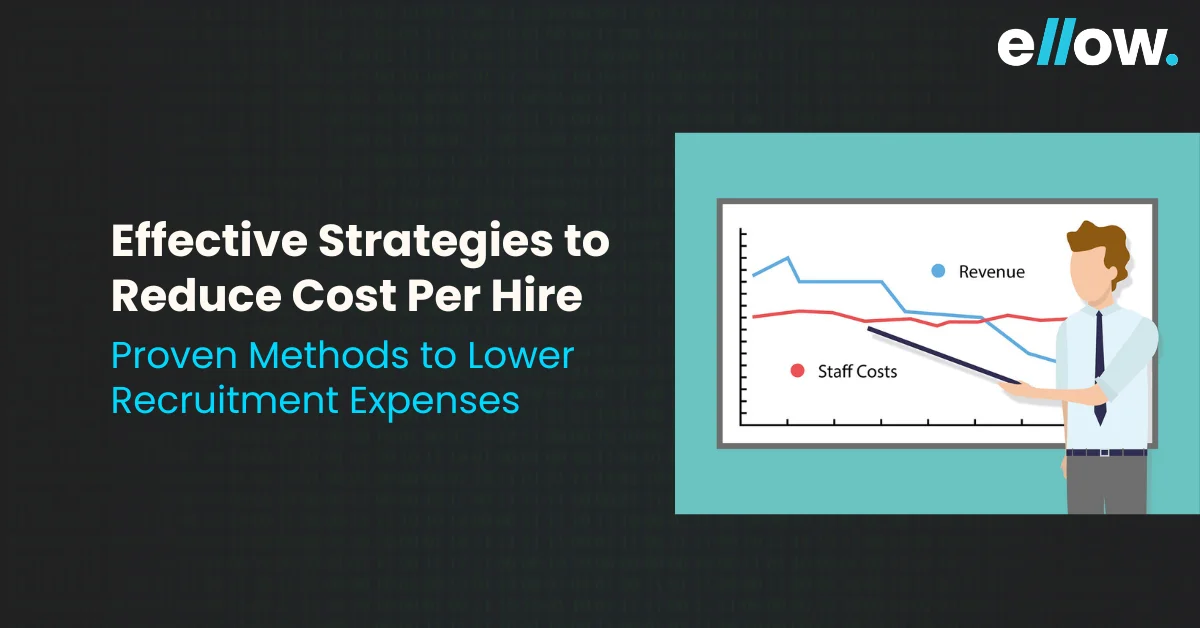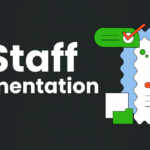Let’s build the future together.
Great ideas need great people. Partner with us to bring your vision to life, or take the first step in your career by joining our team of innovators.

Building a dream team shouldn’t feel like walking a financial tightrope. However, in today’s fiercely competitive job market, the average cost per hire can make even the most ambitious companies feel unsteady.
Recent data suggests that in the US alone, recruiting a single employee can cost a staggering $4,700, with the process often stretching out for weeks.
For emerging businesses, particularly startups and those experiencing rapid growth, these expenses can quickly become a budgetary nightmare.
This article reveals many effective strategies aimed at significantly reducing your cost per hire while maintaining the quality and efficiency of your recruitment process.
Recruitment costs refer to the company’s expenses to attract, hire, and onboard new employees. These costs can vary widely depending on several factors, including the company’s size, the industry, and the specific roles being filled.
Cost per hire is a key metric in recruitment. It represents the average expense involved in hiring a new employee within a specific period. This is calculated by summing all recruitment-related costs and dividing by the total number of hires during that time.
External costs are expenses paid to third parties or for activities outside the organization. These include:
Internal costs are expenses incurred within the organization. These include:
There are additional, less tangible costs associated with recruitment, such as:
Understanding and managing these costs is crucial for an organization to maintain efficient and effective hiring practices.
Leveraging social media is an effective way to attract job candidates. Platforms like LinkedIn, Facebook, Twitter, and Instagram are popular among job seekers.
Posting job openings on these sites can reach a large audience quickly and at a lower cost compared to traditional advertising methods.
Companies can also use social media to showcase their work culture, employee testimonials, and company achievements. This helps build a strong employer brand that appeals to potential candidates.
Engaging content such as behind-the-scenes videos, employee stories, and updates about company events can attract more followers and keep them interested in job opportunities.
Furthermore, social media allows for targeted advertising. Employers can use demographic filters to reach specific groups, such as recent graduates or professionals with certain skills.
This targeted approach ensures that job ads are seen by the most relevant candidates, improving the quality of applications and reducing recruitment costs.
Encouraging employee referrals is an effective way to reduce recruitment costs. When employees recommend friends or acquaintances for job openings, it significantly lowers the expenses associated with sourcing new candidates.
Referrals often lead to quicker hires because employees usually refer people they know are qualified and a good fit for the company culture.
This method also tends to result in higher retention rates, as referred candidates are likely to have a better understanding of the company from their referrer.
Implementing a referral program with rewards can motivate employees to participate actively. These rewards can be monetary bonuses, additional vacation days, or other incentives.
Not only does this save money on advertising and job postings, but it also reduces the time spent by recruiters on screening and interviewing unqualified candidates.
Overall, employee referrals streamline the hiring process, improve the quality of hires, and enhance employee satisfaction by involving them in building their team.
Implementing automation in the recruitment process can save a lot of time and money. Automated tools, such as Applicant Tracking Systems (ATS), help manage large volumes of applications efficiently.
These systems automatically sort and filter resumes, identifying the most suitable candidates based on predefined criteria. This reduces the need for manual screening, which can be time-consuming and prone to errors.
Automation also improves communication with candidates. Tools can send automated emails to keep applicants updated on their application status. Scheduling interviews becomes easier with automated systems that can coordinate the availability of candidates and interviewers.
Moreover, automation enhances the candidate experience by providing a streamlined and professional process. It ensures that no application is overlooked, maintaining a consistent and fair recruitment process.
By reducing the administrative burden on HR teams, automation allows recruiters to focus on more strategic tasks, ultimately lowering overall recruitment costs.
Conducting interviews online can significantly reduce recruitment costs and save time. Using video conferencing tools like Zoom, Skype, or Microsoft Teams allows recruiters to connect with candidates from anywhere. This eliminates travel expenses for both the candidates and the recruitment team.
Online interviews are also flexible, making it easier to schedule multiple interviews in a day. This efficiency speeds up the hiring process, helping companies fill positions faster.
Additionally, video interviews can be recorded and reviewed later, providing more opportunities for thorough assessment and feedback.
Moreover, online interviews help reach a broader talent pool, including candidates from different geographic locations. This broadens the search for the best talent without the need for costly travel arrangements.
Using online platforms for interviews is a practical and cost-effective approach that enhances the recruitment process, making it both efficient and accessible.
Simplifying the assessment process can significantly reduce recruitment costs. Start by clearly defining what skills and qualifications you need for the job. This helps in creating focused and relevant assessment criteria.
Reducing the number of interview stages can save time and resources. For example, instead of multiple rounds of interviews, consider combining several assessments into one comprehensive interview.
Use standardized tests and structured interviews to evaluate candidates consistently. This reduces the chances of bias and ensures a fair selection process.
Implementing pre-employment tests for specific skills can help identify the most qualified candidates early on, reducing the need for lengthy evaluations.
Additionally, providing detailed feedback to candidates can improve their experience and keep them engaged, even if they are not selected. This approach can build a positive reputation for your company and create a pool of potential candidates for future openings.
Focusing on quality over quantity in candidate selection can significantly reduce recruitment costs. Start by creating clear and detailed job descriptions to attract the right candidates.
This helps in quickly identifying those who meet the specific requirements of the role and the organizational culture.
Next, implement structured interview rounds with specific evaluation criteria and benchmarks. By setting clear expectations for each stage of the interview process, you can more effectively screen and assess candidates, ensuring only the most suitable ones move forward.
Using tools like psychometric assessments and predictive analytics can further refine the selection process. These tools help evaluate a candidate’s fit with the company’s culture and predict their potential performance, reducing the risk of costly hiring mistakes.
By being selective, you save time and resources on interviewing and training unsuitable candidates, leading to more efficient and cost-effective recruitment.
Creating and maintaining alumni networks, talent pools, and communities can greatly reduce recruitment costs. An alumni network consists of former employees who might return or refer others. These individuals are already familiar with the company culture and operations, making rehiring smoother and faster.
Talent pools are databases of candidates who have previously shown interest in your company. By keeping their information on file, you can quickly reach out to them when new positions open up. This saves time and money on sourcing new candidates from scratch.
Building online communities, especially on social media platforms, allows you to engage with potential candidates regularly. Share company news, industry insights, and job openings to keep them interested and informed.
Engaged candidates are more likely to apply for future openings, reducing the time and cost spent on attracting new applicants. This proactive approach ensures a steady pipeline of potential hires ready to join your team.
Internal talent mobility refers to promoting employees from within the organization instead of hiring externally. This strategy saves recruitment costs and leverages the existing talent pool.
Employees are already familiar with the company culture, values, and processes, which reduces the time and resources needed for onboarding and training.
Promoting from within also boosts employee morale and motivation, as it demonstrates that the company values and invests in its people. This practice encourages employees to stay longer, reducing turnover rates.
Internal mobility can include job rotations, lateral moves, or project-based assignments. For example, an employee from the marketing department might move to a sales role, gaining new skills and perspectives.
This not only helps in employee development but also ensures that critical positions are filled quickly with competent and experienced staff. Overall, internal talent mobility is a cost-effective way to maintain a skilled and engaged workforce.
Retaining current employees is a smart way to cut recruitment costs. When employees stay longer, you save money on hiring and training new staff. Happy and engaged employees are less likely to leave, which means fewer vacancies to fill.
To keep employees satisfied, offer career development opportunities such as training and coaching. Make sure they have clear paths for growth within the company. Providing a positive work environment is crucial.
Ensure employees feel valued and appreciated by recognizing their efforts and achievements. Regular feedback and open communication help address concerns before they become bigger issues. Competitive salaries and benefits also play a significant role in retention.
When employees see that their well-being is a priority, they are more likely to remain loyal to the company. By focusing on employee retention, you can maintain a stable, skilled workforce and reduce the expenses associated with high turnover.
For short-term or specialized tasks, hiring consultants or outsourcing the work can be a cost-effective solution. Consultants bring expertise to specific projects without the long-term commitment of a full-time hire.
This flexibility allows organizations to address immediate needs without incurring the costs of recruitment, onboarding, and training.
Outsourcing routine or repetitive tasks to freelancers or third-party vendors can also save money. These tasks often require less oversight and can be completed efficiently by external professionals.
Additionally, outsourcing can free up internal resources, allowing your team to focus on core activities and strategic initiatives.
By using consultants or outsourcing, companies can scale their workforce up or down based on project demands. This approach provides access to specialized skills when needed and helps maintain budget control, making it a practical strategy for managing recruitment costs effectively.
Cost per hire is a valuable metric that helps you evaluate and enhance your hiring process. Here’s how you can effectively use cost per hire:
By using these strategies, you can make informed decisions to improve your hiring process and achieve better results while managing costs effectively.
Cost-per-hire metrics help measure and compare the expenses involved in hiring new employees. These metrics are crucial for evaluating the efficiency and effectiveness of your recruitment process.
This formula calculates the average expense of hiring one employee. It includes all internal and external hiring costs divided by the total number of hires during a specific period.
Formula:
Cost Per Hire = (Total Internal Hiring Costs + Total External Hiring Costs) / Total Number of Hires
CPHC is a standardized metric that allows for easier comparison across organizations. It excludes variable costs like referral bonuses and relocation expenses, offering a more consistent basis for comparison.
Formula:
CPHC = ( (Total Internal Costs + Total External Costs) – (Referral Bonuses + Relocation Costs) ) / Total Number of Hires
This metric assesses the efficiency of the recruitment process by comparing total recruiting expenses to the total compensation of new hires.
Formula:
Recruiting Cost Rate= Total Recruiting Expenses / Total Compensation of New Hires
These metrics provide valuable insights into your hiring process, helping you identify areas for improvement and benchmark against industry standards. By understanding and utilizing these metrics, you can enhance your recruitment strategy and control hiring costs more effectively.
Lowering hiring costs benefits your budget and enhances hiring quality and efficiency. By using the strategies we have outlined, you can save money, time, and effort while quickly finding top talent for your company.
Efficient hiring processes not only reduce expenses but also improve overall recruitment outcomes. Keep in mind that hiring is a crucial investment. Smart spending in this area can yield significant returns by attracting the best candidates to your business.
Cost per hire is a metric that calculates the total cost involved in hiring a new employee, including recruitment, advertising, and training expenses.
Reducing cost per hire helps save money, improves hiring efficiency, and ensures better allocation of resources while maintaining the quality of hires.
Strategies include leveraging employee referrals, utilizing social media for recruitment, automating hiring processes, and focusing on internal hiring.
Employee referrals reduce the need for extensive advertising and recruitment efforts, leading to faster and more cost-effective hires.
Yes, using applicant tracking systems (ATS) and other recruitment software can streamline the hiring process, reduce manual work, and cut costs.

Ten Real-World Ways Enterprises Are Using AI Teams to Build Faster in 2026

The Future of Tech Teams and How AI Augmented Engineering Is Reshaping Product Delivery

Staff Augmentation: A Complete Guide to Scaling Tech Teams
Please feel free to share your thoughts and we can discuss it over a cup of tea.
Get a quote
Ten Real-World Ways Enterprises Are Using AI Teams to Build Faster in 2026

Six Things to Consider When Hiring Remote Talent

ellow.io enters remote hires market with AI-based screening process